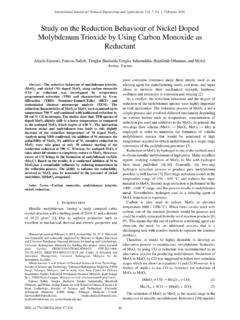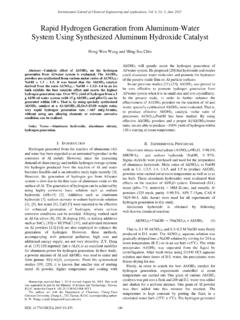Transcription of Simulation and Performance Analysis of Propylene …
1 Abstract The separation of propane and Propylene mixture requires high capital cost and high energy consumption. This challenge is obvious since propane and Propylene have similar molecular size and physical properties. Therefore in the last few years, many processes have been surveyed as alternatives to distillation for this separation. However, researches carried out on these techniques indicated that they have not yet shown sufficient advantage over the distillation process. Therefore the objective of this work is to explore the possibility of establishing optimum operating parameters for better operation of the distillation process for realizing higher product quality and improved energy consumption.
2 In this paper the Simulation and Analysis of an existing Propylene - propane distillation column with 150 trays were carried out. The result of the response optimization showed a product yield of 95% Propylene in the distillate from a minimum of 94% yield, reduced reflux ratio input was saved. It was evident from these results that optimum parameters had been established for better control of the splitter column case study with the potential of achieving higher product quality and improved energy consumption.
3 Index Terms Energy improvement, Performance Analysis , petroleum refinery, Simulation , splitter. I. INTRODUCTION Propylene is one of the most important intermediate petrochemical products. Over the years, it has maintained a remarkable growth in the market on account of increasing demand for polypropylene which absorbs more than 60% of all the Propylene produced worldwide [1]. Other important Propylene derivatives include acrylic acid, acrylonitrile, cumene, phenol, gasoline blend, trimmers and tetramers for detergents.
4 Propylene is commonly produced as a by-product of naphtha and light gas oil feedstock in the steam cracking (SC) and the fluidized catalytic cracking (FCC) units. Currently SC accounts for about 60% while FCC accounts for about 30% of Propylene production [2]. The high cost of crude oil in the past few years made it necessary for producers to seek cheaper feedstock for the refineries. The use of natural gas liquids (NGLs) and shale oil which have high composition of ethane oil have greatly reduced the by-product Propylene .
5 Thus to meet the Propylene market demand producers are gradually adopting Manuscript received June 20, 2016; revised October 17, 2016. Aniediong M. Umo was with the Department of Chemical and Petroleum Engineering, University of Uyo, Nigeria (e-mail: Etim N. Bassey is with the Department of Chemical/Petrochemical Engineering, Akwa Ibom State University, Ikot Akpaden, Nigeria (e-mail: the on-purpose Propylene technology; propane dehydrogenation, olefin metathesis, and methanol to Propylene [2]-[4].))
6 However, irrespective of the Propylene manufacturing route, the product is always a Propylene / propane mixture which must be separated. The purity of the Propylene will depend on the grade; for the polymer grade a minimum of % purity is required, for chemical grade 90-95 % purity and the refinery grade 50-70 % purity are required [3]. Since propane and Propylene have similar molecular size and physical properties, their separation is challenging. This separation is mostly carried out in a distillation column with about 150-200 trays, with a reflux ratio as high as 10-20 and at a high pressure of about 16-26 atm.
7 The process requires high capital cost and high energy consumption. To maximize profit, as energy prices rise, energy efficiency, together with optimizing product quality and maximizing high value product yields have become more important to producers [5]. However, for many years, the standard operating philosophy for distillation process was to maximize reflux for maximum separation. When energy was reconsidered inexpensive, this philosophy held sway [6]. Therefore in the last few years, many processes like absorption, adsorption, extractive-distillation, and membrane techniques have been surveyed as alternatives to distillation for this separation [3], [7], [8].
8 However, researches carried out on these techniques indicated that they have not yet shown sufficient advantage over the distillation process. For example in the use of extractive-distillation, the thermodynamic properties of the investigated extraction solvents tend to exhibit insufficient selectivity to yield an economically viable process. Similarly, the use of adsorption method usually requires several steps to reach a desirable product purity in addition to the use of complicated regeneration cycles, low olefin loadings and high capital costs requirements thus making the system less attractive compared to distillation process [3], [9].
9 Until better alternatives are developed or the present techniques are improved to a level that shows sufficient advantage over distillation, effort must be made to optimize the distillation column to achieve the required result. Therefore the objective of this work is to explore the possibility of establishing optimum operating parameters for better operation of the process for realizing higher product quality and improved energy consumption. II. METHODOLOGY A. Problem Definition The aim of this work is to study the interactive effect of Simulation and Performance Analysis of Propylene - propane Splitter in Petroleum Refinery Case study Aniediong M.
10 Umo and Etim N. Bassey International Journal of Chemical Engineering and Applications, Vol. 8, No. 1, February 20171doi: to and about 106kcal/h ofreboiler energy those process variables involved in the operation of the propane - Propylene splitter in this case study . Sensitivity Analysis will provide a tool that is useful in the optimization of the operating condition of the splitter. The Propylene propane splitter unit in this case study which is conceptually illustrated in Fig. 1, is part of a polypropylene plant which comprises Propylene purification, polymerization, additive and extrusion units.



